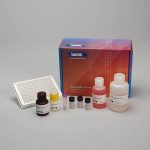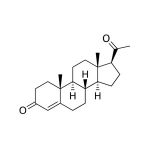Diagnostic Salivary Progesterone ELISA Kit (FDA, CE Mark)
| Specifications |
|
Catalog#: |
1-2502 |
|
Regulatory Status: |
510(k) Exempt, CE Mark |
|
Format: |
96-well plate |
|
Assay Time: |
~ 2 hrs |
|
Sample Volume/Test: |
50 µL |
|
Sensitivity: |
5 pg/mL |
|
Assay Range: |
10 pg/mL - 2430 pg/mL |
|
Storage Requirements: |
2-8°C |
| Tests Per Kit |
|
Singlet: |
78 |
|
Duplicate: |
39 |
References & Salivary Progesterone Research
-
- Tuckey, R.C. (2005). Progesterone synthesis by the human placenta. Placenta, 26(4), 273-81.
- Strott, C.A., Yoshimi, T., Lipsett, M.B. (1969). Plasma progesterone and 17-hydroxyprogesterone in normal men and children with congential adrenal hyperplasia. J Clin Invest, 48(5), 930-39.
- Soules, M.R., Clifton, D.K., Steiner R.A., et al. (1988). The corpus luteum: Determinants of progesterone secretion in the normal menstrual cycle. Obstet Gynecol, 71(5), 659-66.
- Eppig, J.J. (2001). Oocyte control of ovarian follicular development and function in mammals. Reproduction, 122(6), 829-38.
- Veldhuis, J.D., Christiansen, E.C., Evans, W.S., et al. (1988). Physiological profiles of episodic progesterone release during the midluteal phase of the human menstrual cycle: Analysis of circadian and ultradian rhythms, discrete pulse properties, and correlations with simultaneous luteinizing hormone release. J Clin Endocrinol Metab, 66(2), 414-21.
- Junkermann, H., Mangold, H., Vecsei, P., Runnebaum, B. (1982). Circadian rhythm of serum progesterone levels in human pregnancy and its relation to the rhythm of cortisol. Acta Endocrinol, 101(1), 98-104.
- Shah, C., Modi, D., Sachdeva, G., et al. (2005). Coexistence of intracellular and membrane-bound progesterone receptors in human testis. J Clin Endocrinol Metab, 90(1), 474-83.
- Djebaili, M., Guo, Q., Pettus, E.H., et al. (2005). The neurosteroids progesterone and allopregnanolone reduce cell death, gliosis, and functional deficits after traumatic brain injury in rats. J Neurotrauma, 22(1), 106-18.
- Stein, D.G. (2008). Progesterone exerts neuroprotective effects after brain injury. Brain Res Rev, 57(2), 386-97.
- Wagner, C.K. (2006). The many faces of progesterone: A role in adult and developing male brain. Front Neuroendocrinol, 27(3), 340-59.
-
- Brown, S.L., Fredrickson, B.L., Wirth, M.M., et al. (2009). Social closeness increases salivary progesterone in humans. Horm Behav, 56(1), 108-111.)
- Vining, R.F., McGinley, R.A. (1987). The measurement of hormones in saliva: Possibilities and pitfalls. J Steroid Biochem, 27(1-3), 81-94.
- Ellison, P.T. (1993). Measurements of salivary progesterone. In: Saliva as a diagnostic fluid, Malamud, D., Tabak, L., eds. Ann N Y Acad Sci, 694, 161-176.

 Contact: Salimetrics (USA)
Contact: Salimetrics (USA)
